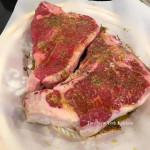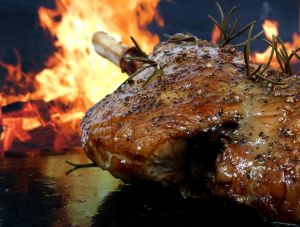The end of summer is fresh produce heaven, which includes delicious vine ripened tomatoes. What do you do when you have a tomato abundance?
Here are some tips for making the most of the end of summer tomatoes.
Sliced: Incorporate into sandwiches or add to basil and mozzarella for a Caprese Salad.
Chopped: You only need a few chopped heirloom tomatoes, mozzarella, chopped basil, and olive oil for a colorful no-cook pasta sauce.
Puréed: There’s nothing like an icy cold gazpacho on a warm day.
Salsa: Fresh salsa is a must have condiment for grilled steaks or shrimp, brown rice and beans, scrambled eggs, and of course, chips.
Grilled: Toss cherry tomatoes with olive oil, garlic, and herbs. Then cook in a grill basket until charred. Top fish, chicken, pasta, and charred slices of bread.
Stored: Keep tomatoes at room temperature until ripe and then use within a day or two. Don’t put them in the refrigerator as it affects their flavor and texture.
Preserved: Roasted, dehydrated, or stewed – savor the season by saving a taste of summer for later.
“Work With What You Got!”
© Victoria Hart Glavin Tiny New York Kitchen © 2017 All Rights Reserved
Now That I Have These Beautiful Butcher Shop Steaks I Am About To Put Them On The Grill. Before I Grill Them, However, I Let Them Sit Out For 1 Hour On A Platter So That They Come To Room Temperature. I Drizzle Them With Olive Oil And Sprinkle With A Favorite All-Purpose Spice Mixture That I Created. These Are Thick Steaks So They’ll Cook On The Grill 7 To 10 Minutes Per Side.
“Work With What You Got!”
© Victoria Hart Glavin Tiny New York Kitchen © 2016 All Rights Reserved
I’ve gotten spoiled and typically don’t care for the grocery store meats. They tend to be bland and tough so most Saturdays I take a trip to the butcher shop. I’ve been reading Bill Buford’s book, Heat, and when the butcher asked me what meats I wanted I thought to myself, “Hmmmm…I think I’ll eat like a Tuscan,” and then blurted out, “I’ll have those two large delicious looking T-Bones!” Life is so much better with a good butcher nearby.
“Work With What You Got!”
© Victoria Hart Glavin Tiny New York Kitchen © 2016 All Rights Reserved
Black Garlic
Black Garlic has been around for quite awhile and is an ingredient that chefs have been using across the country. Think of it as “sweet meets savory.” Black garlic is made when heads of garlic are aged under very specialized conditions until the cloves turn black and have a sticky date-like texture. The taste is delicious and unique with a sweet and earthy umami flavor that intensifies nearly any dish you’re creating.
Garlic bulbs are kept for weeks at low temperatures in a humid environment. The enzymes that give fresh garlic its sharpness break down. These conditions also facilitate the Maillard reaction, the chemical process that produces wild new flavor compounds responsible for the deep taste of seared meat and fried onions.
Black garlic’s flavor is described as tasting like aged balsamic, prunes, licorice, molasses, caramel, and tamarind. Use the cloves as you would roasted garlic. Purée with olive oil for a dense and sweet flavor all its own that compliments steaks, chicken, fish and seafood. Smear the paste on crostini or incorporate it into dressings. Use in a braise to intensify the umami-rich flavor of spare ribs. Add to soups, risotto, noodle and rice dishes, and cheese dips. Black garlic also pairs well with blue cheese.
Black garlic also comes in a dehydrated powder that is considered an umami pixie dust. Just sprinkle a bit of it on anything that begs for depth and earthiness.
Most likely you won’t find black garlic at your local neighborhood market, but some Whole Foods will carry it. I’m lucky enough to get mine at Kalustyan’s in New York City. You can certainly get it online at Amazon or other specialty online food sources.
“Work With What You Got!”
© Victoria Hart Glavin Tiny New York Kitchen © 2016 All Rights Reserved
Pantry & Freezer Staples
How long do pantry and freezer staples last? Staple items are known for their long shelf life, but they don’t stay fresh forever! Use this handy list to determine how long you should keep them on hand.
Freezer
Hamburger & Stew Meats: Shelf Life: 1 to 2 Days Storage: 3 to 4 Months
Ground Turkey, Veal, Pork, Lamb: Shelf Life: 1 to 2 Days Storage: 3 to 4 Months
Bacon: Shelf Life: 7 Days Storage: 1 Month
Sausage (Raw From Pork, Beef, Chicken or Turkey): Shelf Life: 1 to 2 Days Storage: 1 to 2 Months
Fresh Steaks: Shelf Life: 3 to 5 Days Storage: 6 to 12 Months
Fresh Roasts: Shelf Life: 3 to 5 Days Storage: 4 to 12 Months
Chicken or Turkey (Whole): Shelf Life: 1 to 2 Days Storage: 1 Year
Chicken or Turkey (Cut Up): Shelf Life: 1 to 2 Days Storage: 9 Months
Lean Fish: Shelf Life: 1 to 2 Days Storage: 6 Months
Fatty Fish: Shelf Life: 1 to 2 Days Storage: 2 to 3 Months
Fresh Shrimp, Scallops, Crawfish, Squid: Shelf Life: 1 to 2 Days Storage 3 to 6 Months
Pantry
Baking Powder: Shelf Life: 18 Months Storage: Keep In Dry Place In Airtight Container
Beans (Dried & Uncooked): Shelf Life: 1 Year Storage: Store In Cool & Dry Place
Chocolate (Semisweet & Unsweetened): Shelf Life: 18 Months Storage: Keep In Cool Place
Cocoa: Shelf Life: 1 Year Storage: Keep In Cool Place
Cornstarch: Shelf Life: 18 Months Storage: Store In Airtight Container
Flour (White or Whole Wheat): Shelf Life: 6 to 8 Months Storage: Store In Airtight Container or Freeze To Extend Shelf Life
Nuts (In Shell & Unopened): Shelf Life: 4 Months Storage: Freeze to Extend Shelf Life
Spices & Herbs (Ground): Shelf Life: 6 Months Storage: Store in Airtight Containers In Dry Areas Away From Sunlight & Heat. Before Using, Check Aroma – If Faint Replace.
Sugar (Brown): Shelf Life: 4 Months Storage: Store in Airtight Container
Sugar (Confectioners’): Shelf Life: 18 Months Storage: Store in Airtight Container
Sugar (Granulated): Shelf Life: 2 Years Storage: Store in Airtight Container
Vinegar (Unopened): Shelf Life: 2 Years
“Work With What You Got!”
© Victoria Hart Glavin Tiny New York Kitchen © 2016 All Rights Reserved
A Couple Of Flintstone Steaks On The Grill This Fine Sunday Evening
Whenever I come across bison at the butchers I snap it up right away. It’s so much leaner than beef, which I like. I love to grill it and serve with a green salad and corn on the cob. I made sure to marinade these bison steaks a good 24 hours to ensure that they would come out tender and not dry. If you can find bison in your area I highly recommend picking some up. Often times Whole Foods will tend to carry it.
“Work With What You Got!”
© Victoria Hart Glavin Tiny New York Kitchen © 2015 All Rights Reserved














